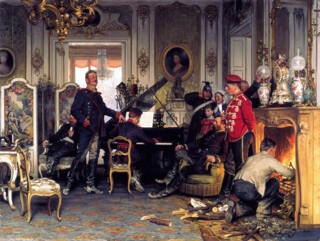That the 19th-century paintings from the Berlin Nationalgalerie should be exhibited at the National Gallery, London (which is, of course, as a collection, international) is a little confusing. They would be more at home alongside the 19th-century pictures in (or once in) the British national collection at the Tate. The Berlin Nationalgalerie, which opened in 1876, had, like the Tate (but much earlier), a remit to collect and display new native work. Like the Tate, it became a gallery of modern, not just native modern, art. Unlike the Tate, as Peter-Klaus Schuster’s essay in the catalogue makes clear, the Nationalgalerie was carried forward, buffeted, and thrown back, by political forces. Its greatest directors were bold in their aims and acquisitions, and suffered for it. In 1896 Hugo von Tschudi, newly appointed, went to Paris and bought work by Manet, Monet, Degas, Rodin and Cézanne: not with state money but donations from Berliners, many of them Jewish collectors with tastes similar to his own. An impressive selection of those pictures is part of this exhibition.
French pictures – the culture of the enemy – in a German Nationalgalerie caused a scandal. The Emperor intervened. Rehangings were reversed; the new pictures were sent upstairs; any additions were in future to be personally approved by the Emperor. Painting in Germany, however, went where Tschudi had pointed. Here, for example, alongside Manet’s 1882 Impressionist Villa at Rueil you can see Max Liebermann’s 1901 Impressionist Villa at Hilversum. The National Socialist dismemberment of the modern collection falls outside the focus of this exhibition, but the expression of the political spirit in art informs nearly all of it. Schinkel’s Neoclassical museum was just one of his contributions as an architect to Imperial Berlin; his paintings here of a Medieval City on a River and of a Gothic Church on a Rock by the Sea, made right at the beginning of the story of German unification in 1815, contributed to the formation of national consciousness. In them a German style (Gothic), storm clouds and the rising sun, stand for national renewal. Caspar David Friedrich’s symbolic stricken oaks and silent moonrise-watchers address the nation’s soul rather than its politics, but there, too, the search for a way to a German national future is evident.
Nationalism and Modernism mix nowhere more strangely than in the work of Adolph Menzel. The Balcony Room – a little sunlit interior in which a sprigged curtain is shifted by a breeze – is a wonderfully attractive piece of direct painting. In England you could put it alongside similar observations of things-as-they-are in work by artists as different as Constable, Lord Leighton and William Nicholson – all of it showing painters enjoying the tools of their trade. Menzel was modern in the sense that the notes he made on the world as he saw it do not pass through the prism of style. Degas admired him as he admired Charles Keene, and one would guess for similar reasons. Menzel’s first big commission was a series of illustrations for a Life of Frederick the Great, and he had, like Keene, an illustrator’s hunger for references and a reporter’s quickness and accuracy. He could draw a horse’s harness and a corpse with equal attention and equal dispassion (he criticised himself for making war pictures without field experience). On the other hand, his most popular work was The Flute Concert of Frederick the Great at Sanssouci of 1852, apparently as common in German school history books as The Boyhood of Raleigh once was here, and to my eye rather less inspired. Late in life, he said with some truth that ‘the King stands like a shop assistant piping a tune to mothers on a Sunday,’ and that he rather regretted having painted it. But it was not his only patriotic canvas and in later ones the observer and the propagandist co-exist with remarkably little friction.
Perhaps the greatest claim this exhibition has on the attention of anyone who does not get to Germany are three of Menzel’s most famous pictures: The Departure of King William I for the Front of 1871, The Iron-Rolling Mill of 1875 and The Supper at the Ball of 1878, all of them pictures which can be given a social or political gloss. Each is, in its own way, a tour de force – Degas painted a sketch of The Supper at the Ball from memory after seeing it in Paris in 1879. No individual stands out from the mass of people: you interrogate the painting inch by inch, searching as you would for a familiar face in a crowd. If it seems to have a certain authority, that is not surprising. Menzel was regularly in attendance at court balls. Sometimes he would stand on a table to get a better view – a gnome overlooking the feast (he was only four foot six high), his pencil noting the glitter of jewellery and epaulettes, the contrast of uniforms and bare shoulders, the chandeliers, the man managing his plate with his cocked hat tucked between his knees, a couple each giving other guests the eye. The artist’s vantage point explains the disengagement you also find in the picture of the King on his way to encourage the troops. There the carriage is a minor incident: the real subject of the picture is a crowd and flags. The Iron-Rolling Mill, a fully fledged industrial interior full of sweat, smoke and the glow of molten metal, is more rhetorical but even there you make your own mind up as to whether toil is noble or industry foul.
Menzel seems to escape the pitfalls of false rhetoric and false sentiment – instead there is a degree of blandness – by keeping observer status. Anton von Werner, in A Billet outside Paris (1894), also the fruit of direct observation, does not. Based on a drawing he made in the requisitioned Château de Brunoy, it shows a group of German soldiers: one at the piano, one standing beside him singing, others in chairs and in front of the fire. The concierge and her daughter, drawn there by the music, stand at the door. The soldiers’ muddy boots and the firewood strewn on the carpet contrast with the marble, gilded panelling and ormolu-mounted Chinese vases. They are thoughtfully engrossed, the concierge is charmed. The picture is disturbing the way some of Norman Rockwell’s Saturday Evening Post covers are, even as it seems to be persuading you that nothing too bad can have happened or will happen; that wars are unfortunate affairs fought by good chaps. The photographic brilliance of the work leaves Rockwell standing, but the perfect wrapping makes the evasion of truth more sinister.
Send Letters To:
The Editor
London Review of Books,
28 Little Russell Street
London, WC1A 2HN
letters@lrb.co.uk
Please include name, address, and a telephone number.


